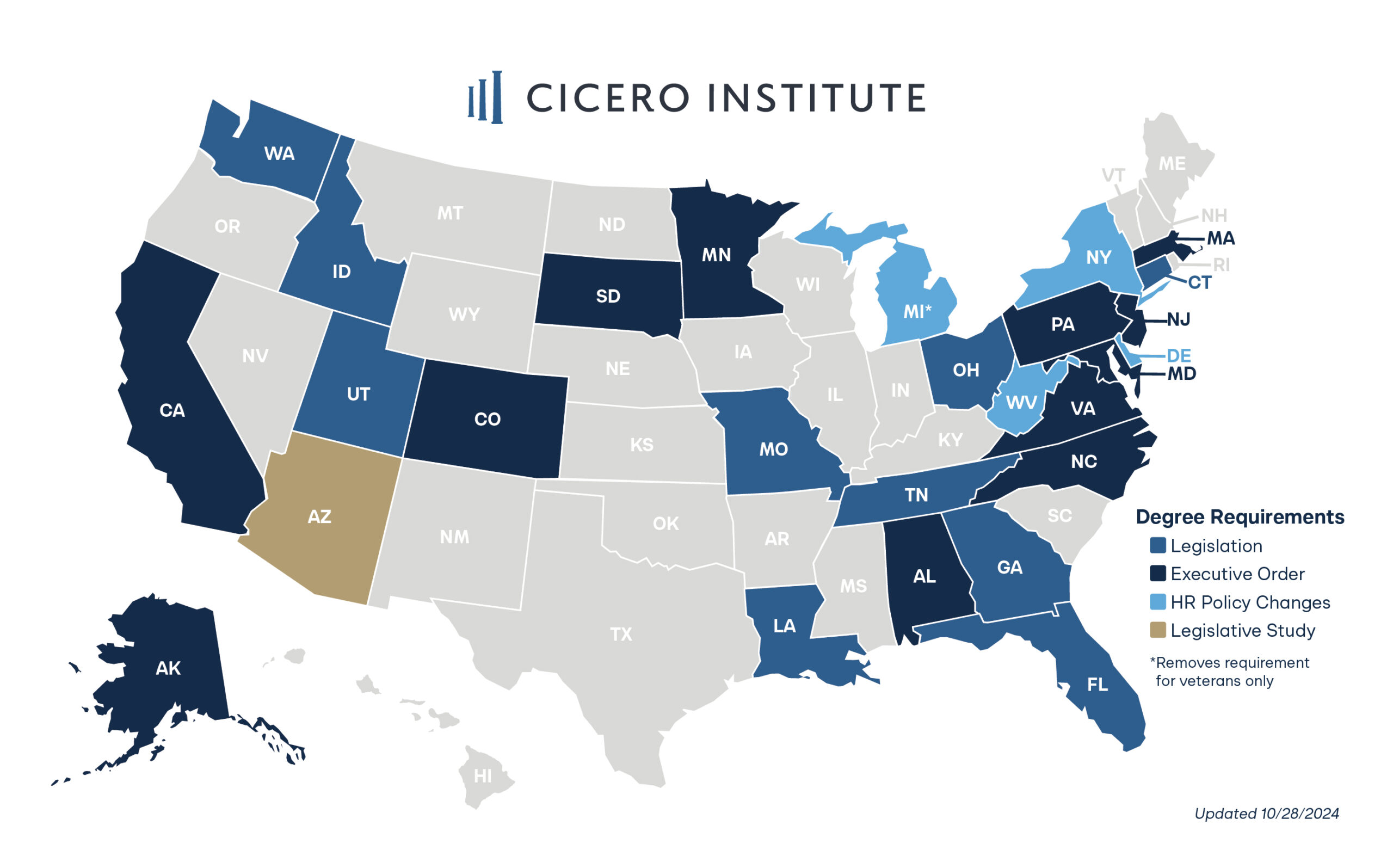
Skills-Based Hiring – Here to stay or just another fad?
Skills-based hiring has become more than just a trend; it is now the preferred practice. From coast to coast, governors in more than 24 states have signed either executive orders or legislation to remove degree requirements for jobs during the last two years (see map below). But the question is, will the public sector change their hiring practices and put pen to paper, or is this just a good news headline?

In recent weeks, skills-based hiring has made headlines both at the federal level via the presidential campaign, as well as at the state level with governors taking executive and legislative action. As we close out 2024 and look ahead to the next year, we anticipate that more states and private companies will shift towards skills or merit-based hiring.
Last spring, individuals from the private sector, public agencies and workforce experts gathered at the NGA Skills-Based Hiring conference in D.C. Everyone agrees that skills-based hiring, a practice that allows employers to make hiring decisions based on an individual’s skills and experience rather than their college degree—or lack thereof—should be the standard. But how many states are implementing this successfully and where do they need help? Realizing the need for change is just one part of the solution; the second is implementation. So, how exactly can states adapt their hiring practices?
State leaders need to take executive action by working with their cabinet secretaries and teams to implement meaningful reforms that even the playing field for skilled workers applying for public-sector jobs.
This practice requires hiring managers and their teams to identify the skills required to successfully execute the duties for each role that the state needs to fill. The process encourages state human resource offices to look past college degrees in cases where prior work experience may be substituted as a skills validation technique. This can be arduous and requires several different stakeholders to be aligned (another hurdle in itself). But, with the right implementation strategy, state agencies can effectively and efficiently identify needed experience for public roles as they become available.
Below are some questions employers and hiring managers should consider when evaluating the skills required for each role.
- How can the state ensure each department buys into this initiative and helps accordingly?
- Who will oversee the process of updating job descriptions and ensuring that skills are adjusted upon review of the role?
- Which positions should move to skills-based hiring first?
- How can the state measure the progress of this initiative and adapt if needed?
- When a role becomes available, who will determine the skills needed for an individual to be successful in this role?
- What businesses in the state have already developed skills-based hiring, and are they willing to provide technical assistance and expertise?
- How can the state encourage schools, nonprofits, and businesses to develop skills training programs to offer citizens a way to develop and market their skills to employers?
Skills validation and the idea of a digital wallet are also increasingly becoming a focus, and hiring managers can prepare by partnering with apprenticeship programs, skills certification courses, and other ‘bootcamp’ programs to ensure they are evaluating individuals appropriately. The increasing emphasis on skills validation should lead to a broader array of more widely accepted certification programs that can help provide the employer with confidence that an individual is indeed qualified for the position to which they are applying. Employers must also consider offering programs not only for entry level individuals, but for middle managers and others looking to advance their careers.
Because so many states have only recently taken executive or legislative action to remove degree requirements, the time horizon for measuring success is relatively short. As these states move to implement these changes, however, they should track relevant hiring data and metrics that can be used to measure the reform’s success‑-and inform other states as they look for models to build their own skills-based hiring changes.
Data states should be tracking and reporting include:
- Total number of state jobs
- Number of vacant positions
- Number of roles expected to turn over yearly (if they are contract positions)
- Number of positions that currently require a college degree
- Number of positions that no longer require a college degree
A detailed implementation plan requires strong leadership across the state government, building off the vision of governors who aren’t afraid to take bold steps to open opportunity. Improving hiring and promotion practices will take time, but as states and localities continue to see the value of skills-based hiring, more will choose to follow their path.

